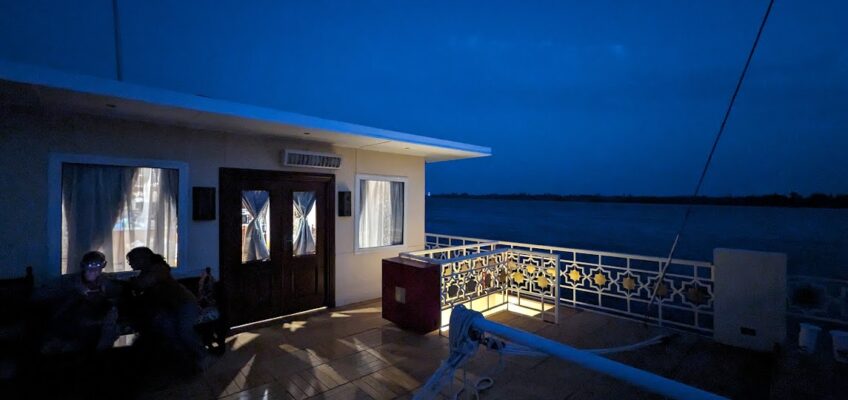After visiting Karnak yesterday morning, we drove out of Luxor about an hour south to Esna. There we visited the small but spectacular Temple of Khnum. Then we boarded our dehabeya “Asiya” and set sail up the Nile (heading south).
After about four hours we stopped for the night at Higz. We met a local resident there and visited her home for tea and conversation. Then it was back to the boat for dinner and an early bedtime.
Now we have just unmoored and are continuing our journey upriver. At the moment I’m sitting on the deck, and there is a lovely breeze. It’s the most pleasant weather since I arrived in Egypt.
Esna
The ancient Greeks called this city Latopolis in honor of the Nile perch, Lates niloticus, the largest of 52 species of perch that inhabit the Nile. The adult males weigh up to 110 kg (242 pounds). So far I haven’t seen any.
When we arrived here, we walked through a market area to the Temple of Khnum. One of the earliest Egyptian deities, Khnum was the god of the source of the Nile. Since the annual flooding of the Nile is associated with the cycle of life, Knhum was worshipped as the creator of children, which he created from clay and placed in their mothers’ wombs. He he had the titles “Divine Potter” and “Lord of created things from himself.” He is typically depicted with the head of a ram. Don’t ask me why.
Honestly, I can’t keep track of all the gods. Mo points them out in the wall paintings and carvings, and their names are just a blur in my brain. Plus various kings are associated with different gods from whom they derive their divine authority. It’s all just a jumble of information. I would bore you with all the details, but I don’t remember any of it.
Temple of Khnum
The Temple of Esna, though, I won’t ever forget. Though small, it is maybe the most spectacular temple we’ve visited so far in terms of the brilliant colors of the decoration on the walls and columns. It was constructed by Thutmosis III in the 15th century BCE, but not completed until the Ptolomeic and Roman period, between 40 and 250 CE. According to inscriptions on the walls, those who entered the temple had to cut their fingernails and toenails, remove other body hair, wash their hands, dress in linen, and have no sexual intercourse for several days.
Restoration is still in progress. Many of the colors hide behind a layer of black soot and bacteria after years of burial. Workers on scaffolds were busy inside while we were there, but more than half the temple displays its once-hidden brilliance.
On the way back to our bus, I stopped in one of the shops and bought my second miniature vase of the trip. (The first I bought at the Temple of Hatshepsut.) I’m feeling pretty good about my bargaining skills so far. The first one, he asked 2,000 Egyptian pounds. I got it for 500 (about $16 US). And this one, he asked 1,200 and I got it for 520.
The cruise begins
After our visit to Esna, we boarded our dehabeya. It’s a charming small vessel, just nine cabins. A tugboat is dragging us upriver. Later this afternoon the schedule says we will be raising sails, but I doubt that means we will proceed under wind power alone.
Once we were on board, we enjoyed a buffet lunch, watched a safety briefing video, and had time to relax and enjoy the passing scenery. It actually looks almost exactly like what you’d expect the Nile River to look like, lined with palm trees, sugar cane, and other lush green vegetation, and the occasional small city or village.
I believe OAT actually owns this boat (and several others). There is OAT branding all over: in the safety video, on the crew members’ nametags, on the soap and shampoo dispensers in my bathroom, on the menus… well, on just about everything.
Higz
We stopped for the night at Higz, a village of about 5,000. We didn’t really get to see the village at all, but we met Azmaa, a local resident, and we visited her house on the outskirts of the town, not far from where we moored.
Azmaa has been working with OAT for about three years. She didn’t speak any English before that. She told us she is learning with Google and Duolingo. Her husband works for a hotel and is away for six weeks at a time, then home for ten days. They have a seven-year-old daughter. Her extended family, including her mother, her sister, aunts, uncles, and cousins, live with them (that’s what she said), though they go home to sleep. They were all there. We sat outside and had tea together.
Next up
We have a light schedule today. Before lunch we will stop at Edfu to visit another temple. The rest of the day we are just sailing along. And it should be a lot cooler today. The forecast high in Edfu is just 104 degrees!



Leave a Reply